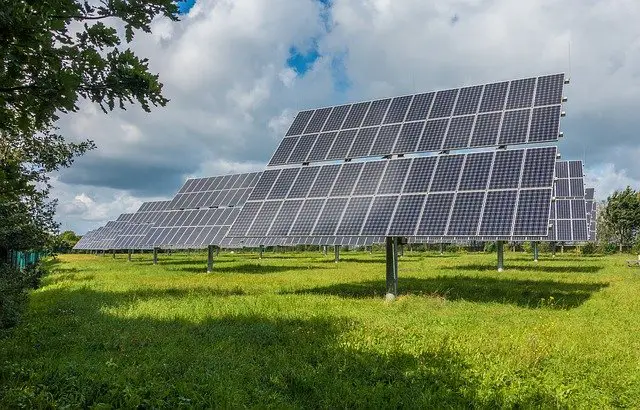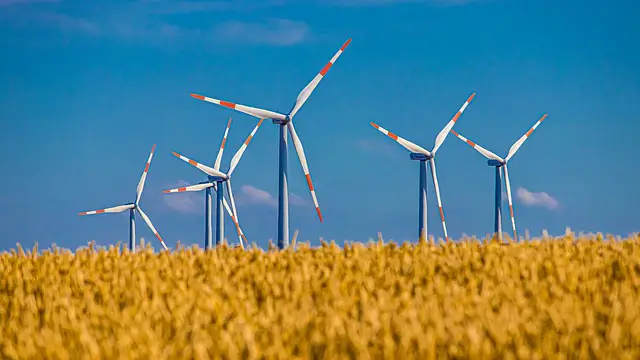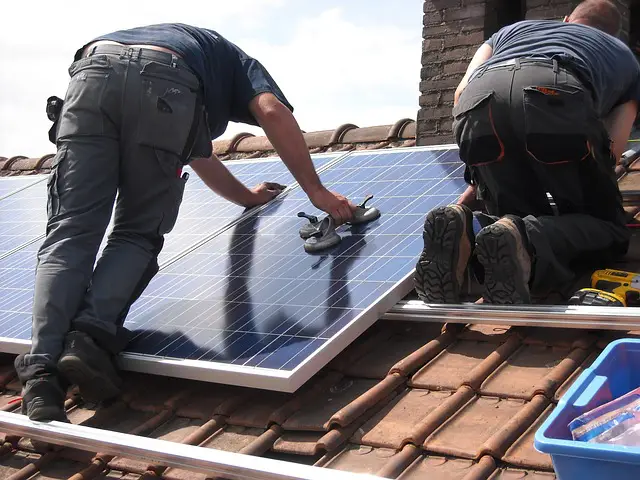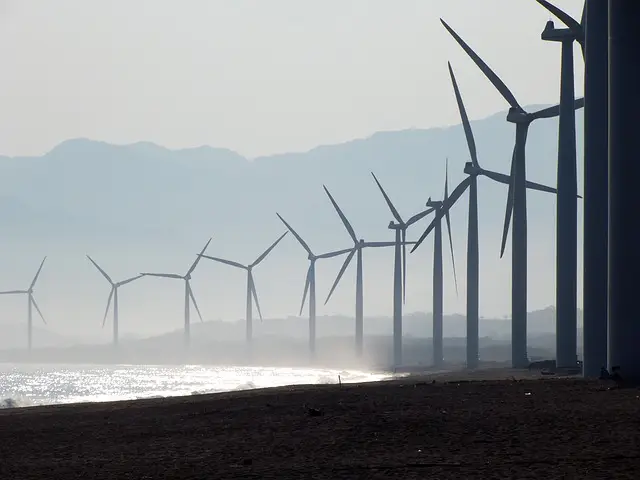When it comes to choosing the best renewable energy option to power your home, the dilemma of solar vs wind energy sets in for most people. So, which one suits you best?
Embracing either of these two options allow you to make that switch, from paying the ever-rising electricity bills to cheaper and cleaner options.
Also, moving from the use of fossil fuels as a source of energy is not only beneficial to you economically, but it’s also environmentally friendly. It helps reduce the carbon footprint as well as save on taxes.
Therefore, more and more homeowners in the U.S and worldwide are embracing the use of alternative sources of energy to reap these benefits.
But which of these two different sources of renewable energy is best?
Well, to help make your choice easier, this piece will break down each of them, explore the type of environment each is suitable for, and look at the pros and cons of each. Also, we’ll look at the application examples of each.
Solar Energy vs Wind Energy: What is the Difference?
Both solar and wind energy are intermittent (depending on weather patterns), and each works better in certain locations than in others. To understand better the difference between them, let’s first look at the meaning of each.
What is Solar Energy?
Solar energy is the radiant heat and light power generated from the sun.
This power is harnessed using a wide range of technological devices, including photovoltaic, solar heating, solar architecture, solar thermal energy, artificial photosynthesis, and molten salt power plants. To harness power from the sun, the system used remains stationary.
Solar power technology works in almost all parts of the world every day, as the only essential element needed is enough sunlight exposure. You can generate solar power on sunny and cloudy days- though the estimated range of power generated on cloudy days is about 10 – 25% of the normal solar power output.
What is Wind Energy?

On the other hand, wind energy is the process of generating mechanical power and electricity using the wind. The power is harnessed using wind turbines that help convert the winds’ kinetic energy into mechanical power.
Wind energy is mostly generated in locations where the wind blows at average speeds of around 12mph. Wind speeds are paramount when considering wind power production as the wind resource may vary significantly over a region of just a few miles apart. This is mainly due to differences in the local terrain, which impacts the wind flow.
So, what are the main differences between these two sources of renewable energy?
Solar vs Wind Energy: The Cost of Installation
To fully make the most of your renewable energy investment, you have to weigh the cost of installation and the money it will save you compared to the regular power.
In estimating the cost of installation for solar or wind energy, there are several variables to consider. These include the systems’ size, local incentives & ordinances, and environmental exposures such as wind or sunlight.
The Cost of Installing Solar Energy
To install solar energy costs an average of $2.19 per watt for both commercial and residential installations. The larger your solar system, the more you’ll pay per watt and vice versa. The system starts to pay itself, with each kilowatt-hour of free electricity it generates.
The longer the average lifespan of a system is, let’s say 25 to 30 years, the more savings of free electricity you accumulate over time.
The Cost of Installing Wind Power
Wind turbines, on the other hand, mostly serve big, utility-scale use and may cost millions to install. For smaller commercial and residential properties, the cost varies based on the tower’s height and the type of equipment you install. American Wind Energy Association indicates that you can pay up to $1.50 per watt of electricity generated.
In conclusion, while a 10kW solar system costs about $21,900 after ordinances and incentives, a 10kW wind turbine could cost up to $14,700, also after incentives.
Wind turbines are cheaper, but they cost a lot to maintain than solar energy. Also, unlike solar energy that can still be generated in snowy, cloudy, and rainy areas, wind energy is not feasible in some areas and during certain weather conditions.
Wind Power vs Solar Energy: How they Work
How Does Solar Energy Work?

Solar power is generated when light from the sun converts into electricity. Here’s the step by step process:
- The sun’s energy is released as photons that hit the PV cells, which in turn loosen the electrons. These PV cells have silicon, which contains a positive and a negative layer. This silicon creates a circuit where electrons flow to generate electricity.
- A solar system, which consists of numerous solar panels, must have a central inverter (or micro-inverter, based on the system setup). This inverter helps transform the direct current (DC) electricity produced into alternating current (AC) electricity, suitable for your home use.
- The AC goes to a switchboard that sends the electricity to your home appliances. The switchboard makes sure that your appliances first use solar energy, only allowing access to the grid power if solar energy power is insufficient.
- Solar power energy production requires very minimal maintenance. In fact, with solar power, you don’t have to keep switching it on or off because the system does that automatically.
See Related: Best Off-Grid Greenhouse Heating Systems
How Does Wind Energy Work

The wind is air in motion. It blows when the sun heats a certain part of the land along with the air above it. In turn, the heated air goes up to replace the cooler air. The cooler rushes in to fill the vacuum, thereby creating a gust of wind.
So, how is wind energy produced?
- Wind energy is generated using wind turbines which convert the energy in the wind into electricity. To do that, the wind applies force on the slender blades, which are usually 2 to 3, triggering them to spin. These spinning blades, in turn, cause the conical cap or the rotor on the turbine and an internal shaft to rotate for 30 to 60 revolutions per minute.
- This causes an assembly of magnets in a generator to spin, generating voltage in a wire coil due to electromagnetic induction.
- Since generators need faster revolutions to produce electricity, a gearbox is used to link the lower shaft to a speedier shaft. This increases the spinning rate to around 1000 to 1800 (RPM) revolutions per minute.
See Related: Important Pros and Cons of Wind Energy
How Much Energy Does a Wind Turbine Produce Per Rotation?
A report by Acua shows that where the wind blows at over 12 miles an hour, a wind turbine can produce electricity of at least 1.5 megawatts.
When the wind speeds reduce, the production of electricity also drops. And, when the speeds go over 45 miles per hour, the turbines shut down to protect the machinery operating it.
See Related: Different Uses for Solar Panels
Solar vs Wind Energy: Pros and Cons
What are the advantages and disadvantages of solar energy?
Studies show that an hour’s sun can provide enough power to meet the global energy needs for a year. This undoubtedly shows that the sun is a powerful source of clean energy. If we can collect even a fraction of this sun’s energy, it’s possible to never again use the ever-diminishing energy sources.
Luckily, the following factors seem to give more people access to this renewable energy:
- Advancements in technology in the 21st century coupled,
- The increasingly competitive solar panel prices in the market
- Availability of solar grants
However, while this source of energy comes with numerous benefits, it’s not without its downsides. Here are the key advantages and disadvantages of solar power you need to know:
See Related: Important Pros and Cons of LED Lightings
Advantages of Solar Energy
-
Solar Energy is a Clean Energy Source
Is solar energy renewable? Certainly yes!
Since solar energy is accessible as long as there’s sunlight, we can harness its power in almost all parts of the world, any day, and never run out.
This is a source of power that is here to stay, provided there’s sunlight.
See Related: Sunrun vs Sunpower: What’s Better?
-
Lowers the Electricity Bills
Harnessing the power of the sun reduces reliance on power from the electricity grid. So, your energy bills drop significantly.
This is one of the biggest benefits of solar energy. The more power your solar system produces, the lower your grid electricity usage.
In addition, you’ll not only save on electricity bills, but you also have the potential to receive payments. This will come from any surplus energy that you export back to the grid through the (SEG) Smart Export Guarantee.
Get a quote for solar installation with EnergSage in minutes. You’ll find the lowest price possible.
See Related: How Are Fossil Fuels Taken from the Earth?
-
Low Maintenance Costs
After covering the initial cost of installation, solar energy systems don’t require a great deal of repair and maintenance. You only need to change the inverter after 5 to 10 years. The cables also require repair and maintenance to ensure that the system works at maximum efficiency.
Other than those few parts, all you require is to keep the solar system clean, something you can do just a couple of times every year. Solar panels systems are long-lasting since the system remains stationary most of the time, meaning there’s no wear and tear.
In fact, when purchasing, most manufacturers offer up to 25 years of warranty.
See Related: Sunrun vs Sunpower: What’s Better?
Disadvantages of Solar Energy
-
High Cost of Purchase & Installation

The initial cost of solar power systems is relatively high. This cost includes purchasing the solar panels, batteries, inverters, wiring, and even installation.
However, since technology keeps changing and getting cheaper, this cost is likely to drop in the future.
-
Weather Elements Dependent
Solar panels depend on sunlight’s availability to work effectively, and thus the system cannot collect solar energy at night. Even though it’s possible to collect solar energy when it’s rainy or cloudy, the system’s efficiency goes down in such weather conditions.
-
Solar Systems Use a Lot of Space
If you desire to produce lots of electricity, say, for commercial use, then you’ll need to install many solar panels to collect as much sunlight as possible. The panels will take a lot of space, and some roofs are not big enough to fit them all.
In that case, you’ll need to install some solar panels in your yard and ensure the place is exposed to direct sunlight. If you don’t have a larger yard, this will be quite an inconvenience, and you’ll have to seek an alternative to satisfy all your needs.
-
It Expensive to Store Solar Energy
Solar energy is used as it’s being produced, and the excess is usually stored in batteries. You can charge these batteries, during the day so as to use the energy at night.
Though this makes solar energy a reliable source for 24 hours, the batteries used to store energy for night use are pretty costly. This makes solar energy only efficient and cheap to use during the day. At night, most people revert to the grid energy (if connected).
-
It’s Associated with Pollution
Solar energy systems pollute the air, although the pollution associated with them is far less compared to other sources of energy like coal.
The emission of greenhouse gases occurs during the transportation and installation of solar systems. Also, toxic materials are released during the PV systems manufacturing process.
Advantages of Wind Energy
Just like with solar energy, there are several advantages and disadvantages of wind energy. Here are the most common ones:
-
It’s Clean and Renewable
This helps to answer a pressing question in most people’s minds; is wind energy renewable? Well, unlike coal, oil, natural gas, and other sources of energy, wind energy does not result in emissions of greenhouse gases.
Also, wind turbines do not require the use of fossil fuels to operate. Wind energy is, therefore, renewable energy and one that can never run out.
-
Wind Energy is Space-efficient
Wind farms may take up a lot of space, but the actual equipment and turbines don’t use up much land. This means that we can still use the land used for the land turbines installation for other uses like farming.
-
Low Operating Costs
While wind farms and individual turbines may be expensive to install, it requires relatively low costs to operate when they are up and running.
The fuel is the wind, which is free, and the turbines require minimal maintenance throughout their lifetime.
Disadvantages of Wind Energy

-
Wind Energy is Intermittent
The effectiveness of wind turbines depends on weather elements. It’s therefore hard to predict the exact amount of electricity the wind turbines will generate over a given time.
For wind energy to be used exclusively, we will need technology to store the energy produced when the wind is strongest.
-
It Causes Noise and Visual Pollution
The spinning of wind turbines can be pretty noisy when in operation due to mechanical operation and wind vortex created during the spinning of the blades.
Also, the wind turbines require to be built high up or in raised locations to capture a considerable amount of wind. This often interrupts the scenic landscapes, including hills, mountain ranges, oceans, lakes, etc.
-
Negatively Affects the Environs
When the blades are spinning at very high speeds, they can kill or harm certain animal and insect species, flying around like bats and birds.
Moreover, wind farm constructions also disrupt the natural habitats of some local species when not done sustainably. Technological advancements are being used to solve some of these issues, like building properly-siting wind farms.
Common Application Examples
Solar Energy Examples of Application
We can use harnessed solar power energy in a variety of modern-day technologies and gadgets. Some of the most common examples include:
-
Solar Heating
Solar energy is applied in solar water heaters and space heaters. While water heaters utilize water for thermal transfer, space heaters use liquid or air to convert sunlight into thermal energy.
This enables homeowners to heat their homes and pools like these solar heaters for pools.
-
In Lighting or LED Technology
People also use solar battery-charged systems for indoor and outdoor lighting. To use it at night, the batteries are charged during the day.
-
In Cooking
Many households are now embracing solar power in daily activities like cooking. You only need a thermometer, Styrofoam insulation, duct tape, aluminum foil, pan, cooking bag, and a box.
Cooking with solar energy saves you money and conserves our environment.
-
Charging Electronics
Solar power is also being used to keep our electronics and gadgets like tablets, smartphones, wearable’s, e-readers, and music speakers, running.
It is a reliable source of backup power, but it can also serve as the main source. Check out these portable solar chargers.
Wind Energy Examples of Applications

Wind energy can also be used to power a lot of things in residential homes and commercial properties. Some of the common wind energy examples include:
- Powering and generating electricity for home use
- Pumping water
- Milling grains
- Powering cargo ships (via kites)
- Sailing
- Land surfing
- Windsurfing
- Kiteboarding
- Kite surfing
5 Examples of Wind Energy Companies
-
General Electric — 4,264MW GE Haliade 6MW Wind Turbine Blades
Leading the pack is GE, which installed more wind turbines in the US in 2020 than any other company. It’s one of the biggest players in the wind energy industry, having commissioned 4.3 GW of wind energy in 2020/19, which was a 42% rise from 2018.
GE is ranked fourth with around 7.4 GW, and it produces the largest turbine known as Haliade-X.
These turbine blades reach up to 107 meters in length, and one single turbine can generate enough electricity to power about 16,000 homes.
-
Goldwind — 14 MW
Headquartered in Beijing, Goldwind is a wind-giant and one of the largest China wind-turbines manufacturers. It’s the third-largest wind-turbine manufactures in the world, commissioning over 8GW in 2019. It has over 50GW of installed capacity worldwide across over 32,000 turbines.
Although it has a small foothold in the US market, BloomBergNEF (BNEF) shows that Goldwind commissioned 14MW of wind energy in the U.S in 2019.
-
Nordex — 548 MW
This Hamburg-based company is gradually gaining traction in the US market. It is one of the four giant wind energy manufacturers, and it commissioned over half a GW of wind energy in 2019 in the country.
Although smaller than Goldwin, it took position 8 in 2019 and commissioned 27GW of wind energy globally.
-
Vestas — 3,029 MW
Vestas, a Danish manufacturer, is also one of the largest wind-turbines producers. It commissioned almost 10GW of wind energy worldwide in 2019.
Vestas is also a major wind energy player in the US, as it installed above 3GW of wind energy in 2019 and took the title of the best installer in 2018.
-
Siemens Gamesa — 1,460 MW
Siemens Gamesa, a German conglomerate, acquired Spain’s turbine manufacturer in 2017. This company is one of the big wigs when it comes to manufacturing and installing wind energy.
Siemens Gamesa installed almost 1.5 GW of wind capacity in the US in 2018. And, it has won numerous contracts, including the Dominion Energy Company.
Siemens commissioned nearly 9 GW of wind energy globally in 2019.
